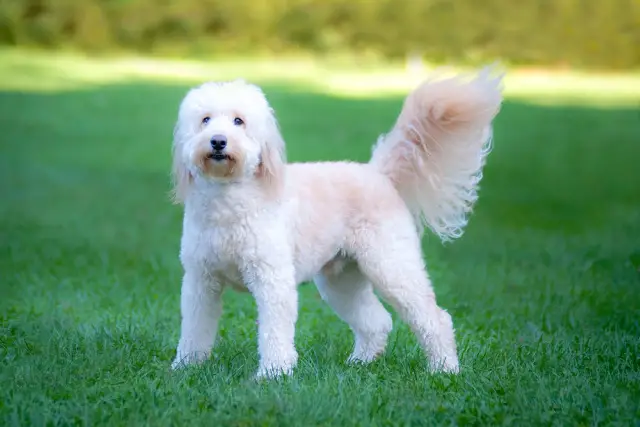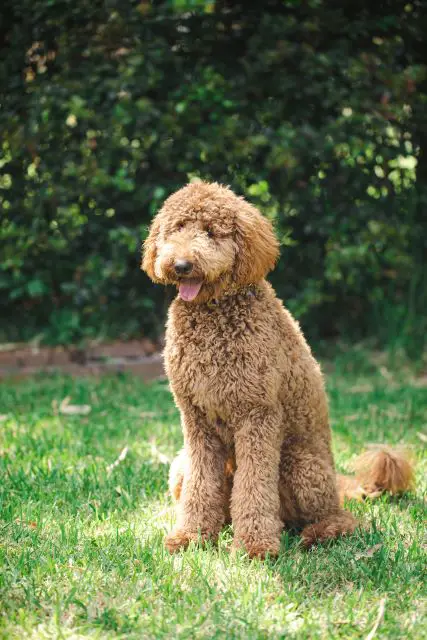If you are trying to buy a Goldendoodle from a breeder, some of the vocabulary that they use can be a little bit overwhelming. If you want to know what all the terms referring to the Goldendoodle’s generation mean, then you are in the right place. We’ll also look at some of the differences between them so you can decide which Goldendoodle dog is the best for you.

Goldendoodle F1, F2 and F3 are all 50% Poodle. F1b, F2b, and anything else with a single ‘b’ is usually backcrossed with a Poodle, in this case making it 75% Poodle and 25% Golden Retriever. F1bb, F2bb, and others are backcrossed twice, making them as much as 87.5% Poodle which results in a very Poodle-like coat.
Table of Goldendoodle Generations Explained
In my experience, the differences between Goldendoodle generations can be a little bit difficult to visualize. Let’s look at the table below, where an overview of the different Goldendoodle generations has been summarized in order to simplify the differences.
| Type | Parent 1 | Parent 2 | Generation |
| F1 Goldendoodle | Poodle | Golden Retriever | 1st |
| F1b Goldendoodle | F1 Goldendoodle | Poodle (sometimes Golden Retriever) | 2nd |
| F1bb Goldendoodle | F1b Goldendoodle | Poodle (sometimes Golden Retriever) | 3rd |
| F2 Goldendoodle | F1 Goldendoodle | F1 Goldendoodle | 2nd |
| F2b Goldendoodle | F2 Goldendoodle | Poodle (sometimes Golden Retriever) | 3rd |
| F2bb Goldendoodle | F2b Goldendoodle | Poodle (sometimes Golden Retriever) | 4th |
| F3 Goldendoodle | F2 Goldendoodle | F2 Goldendoodle | 3rd |
Goldendoodle Generation Names Explained
As can be seen above, Goldendoodle generations are made up of three characters. There is always an ‘F’ present, followed by a number. There may also be a ‘b’ present. But, what do they mean?
What Does ‘F’ Mean?
‘F’ stands for filial. This is a fancy, scientific term, which basically just means that the dog is a hybrid. It is present in the generations of all Goldendoodles because all of them are hybrids.
What Does the Number Mean?
The number refers to the generation of the hybrid. Specifically, how far away it is from one of the parent breeds. If a Poodle and a Golden Retriever are bred together, that puppy is one generation away from the parents; hence it is an F1 Goldendoodle.
If that F1 Goldendoodle puppy is crossed with another F1 Goldendoodle, the offspring is two generations away; or F2 Goldendoodle.
What Does the ‘b’ Mean?
In some cases, the letter is capitalized, in others, it is not. It does not matter though, and always refers to backcrossing. This means that the hybrid has been bred with a purebred dog of one of the original breeds.
In the case of the Goldendoodle, backcrossing is usually done with another purebred Poodle.
If you backcross an F1 Goldendoodle, the offspring is F1b Goldendoodle (or F1B). If that dog is backcrossed again, it is F1bb Goldendoodle. And so on.
Hybrid Vigor in Goldendoodles

Hybrid vigor is also something that you may hear breeders talking about a lot. Yet again, it is a fancy, scientific term. It essentially means that, because the two breeds have been crossed so recently, the strongest and healthiest genes are portrayed in both.
Generally, this means strong immune systems and fewer inherited diseases. But it does not necessarily guarantee a healthy Goldendoodle puppy.
Differences Between Goldendoodle Generations
Now that we understand what the terminology means, and can identify how the different generations of Goldendoodles were created, let’s look at some of the differences between them so that you can decide which one might be the best for you.
F1 Goldendoodle
The F1 Goldendoodle is one of the most common Goldendoodles. It is very easy to create one by breeding a Poodle and a Golden Retriever. Because of this, they are one of the cheaper options at around $2000.
They are 50% Poodle, and 50% Golden Retriever. This results in coats that tend to be a little bit unpredictable. They can be similar to either parent or somewhere in between.
F1 Goldendoodles will probably not shed as much as a regular Golden Retriever, but they will still shed far more than a Poodle. This means they are not ideal for those with allergies.
F1 Goldendoodles will have the greatest advantage in terms of hybrid vigor of all the Goldendoodles.
If you want a strong, healthy dog, and do not mind the coat, the F1 Goldendoodle may be for you.
F1b Goldendoodles
F1b Goldendoodles are backcrossed with a Poodle. The puppies that result are 75% Poodle and 25% Golden Retriever. It is very rare, although possible, that the backcrossing would have been done with a Golden Retriever, so make sure that you confirm with your breeder.
In the case of a 75% Poodle F1b Goldendoodle, the coat would be far more curly. It would also be slightly more coarse, and would not shed as much as an F1 Goldendoodle.
Although still not as great for those with allergies as a Poodle, they are a very good option and still benefit from hybrid vigor.
F1b Goldendoodles are the most expensive and can be as much as $5000 to $6000. They are definitely not in everyone’s price range and are usually favored by breeders who want their favorable characteristics.
F1bb Goldendoodles
The F1bb Goldendoodle, as can be seen in the table above, occurs when an F1b Goldendoodle is backcrossed with another Poodle. This means that they are 87.5% Poodle.
Their coat will be the most like the Poodle’s out of all the Goldendoodle options. This means that they are the best options for those who suffer from allergies.
Out of all the Goldendoodles, double-backcrossed ones do require the most grooming. They should be brushed daily, so make sure that you are willing to commit this time to them and have the proper tools including a slicker brush like this one.
The cost of F1bb Goldendoodles varies depending on the breeder and the demand. You can expect to pay an average of about $3000 for one.
F2 Goldendoodle
F2 Goldendoodles are created by breeding two F1 Goldendoodles together. Although they may still benefit from some hybrid vigor, it is greatly reduced.
Their coats vary just as much as those of F1 Goldendoodles but are more difficult to predict due to the existence of recessive genes.
These are not often produced by breeders because of this unpredictability, and the fact that there are far quicker ways to get a 50% Poodle hybrid. Usually, they occur accidentally, in a family home.
Generally, they cost the same as an F1 Goldendoodle at about $2000, but the price may vary from puppy to puppy depending on the characteristics present.
F2B and F2BB Goldendoodles
These are the rarest Goldendoodles of them all. They can be very different, but in most cases backcrossing them with a Poodle results in enough of the Poodle’s characteristics that they have very coarse, curly coats that require a lot of maintenance.
Depending on the genetics of the F2 Goldendoodle used, they may shed very little or a moderate amount.
The more Poodle-like they are, the more expensive they tend to be. They can range between $1000 and $5000, with F1bb usually slightly more expensive.
Multigenerational Goldendoodles

You can mix any two dogs together that only have Poodle and Goldendoodle genetics in them, and the result would still be considered a Goldendoodle. For example, you can Mix an F1bb with an F1. Or an F2b with an F1b.
This means that there are endless variations of Poodle and Goldendoodle combinations, with various percentages of each breed in them.
These are simply referred to as multigenerational Goldendoodles. For the sake of simplicity, everything from F3 onwards automatically falls into this category.
Although there is nothing inherently wrong with multigenerational Goldendoodles, they may not be the best option for you. This is because not much care has been taken in their breeding. They usually have very little advantage in terms of hybrid vigor too.
There are, of course, exceptions to the rule. If you are uncertain, ask your breeder to explain the heritage of the puppy. If they can’t, it might be best to reconsider your purchase.
Further Reading:
- Male Vs Female Goldendoodle Dog: Differences Explained
- How Big Do F1B Goldendoodles Get? (Size/Weight Guide)
- 11 Goldendoodle Health Problems To Know Before Buying
- The Pros and Cons of a Goldendoodle’s Temperament
- Understanding the Barking Habits of Goldendoodles
- Making A Splash: Do Goldendoodles Like Swimming?
- Average Life Expectancy of a Goldendoodle Dog (All Sizes)
- Are Goldendoodles Hypoallergenic and Do They Shed?
- Goldendoodle Coat Types and How to Care for Them
